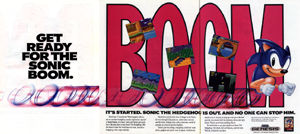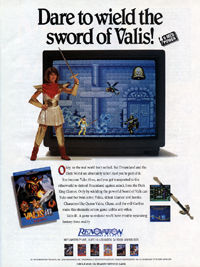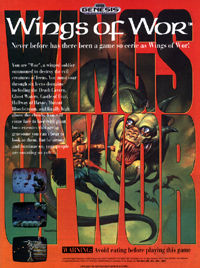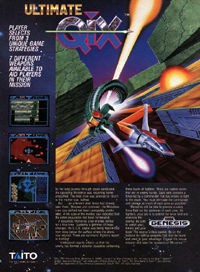

"Sega doesn't plan to give up. For the last year they have been working quite secretly on a line-up of new super softs. Where the S-NES programmers are just learning their system, the Sega people are starting to bring out the second generation of Genesis games. Sonic the Hedgehog, Fantasia and Streets of Rage are good examples of the new breed of games."
- Ed Semrad, EGM July 1991
Sega 4 megabits By 1991, the Genesis system already had a fantastic library of games, but none of them had really captured the imagination of the gaming masses like Nintendo's Super Mario Brothers series had done. The release of Sonic the Hedgehog, however, finally gave Sega a "mascot" character with mass appeal, as well as a gaming series which would propel the Genesis to mainstream success. Released in June of 1991, Sonic the Hedgehog gave Sega some much needed ammunition with which to fight the impending launch of the SNES in North America. Specifically, Sonic compared quite favourably to Super Mario World, Nintendo's flagship title for the supposedly technologically superior SNES. Later in the year, in an uncharacteristically bold move, Sega dropped the price of the Genesis system from $189 US to $149 and axed Altered Beast in favour of Sonic the Hedgehog as the pack-in game. Sonic was very well received both critically and commercially in 1991, and rightfully so. The game's graphics, for instance, seem to have taken into account everything that Sega's programmers and artists had learned about the Genesis system's hardware over the previous two years. Lights glisten and shimmer in the Casino stage; a distant lake subtly line scrolls as you speed past it in the Green Hill Zone; multiple layers of parallax scrolling are evident everywhere you look. The Genesis system manages to shift all of this elaborate scenery around at a lightning fast pace, with very little flickering or slowdown present. The music and sound effects are equally inspiring, demonstrating once more that the Genesis system's sound chip was more than up to the task of pumping out some quality audio. The background music for the Green Hill Zone, for example, is particularly memorable, as is the "ring pick-up" sound effect, which would go on to be used in future games in the series up to the present day. The most compelling aspect of Sonic the Hedgehog, however, is Sonic himself. If the player leaves Sonic alone for a few seconds, he'll turn to face outwards from the screen as if to ask: "What are you waiting for?" When he's near the edge of a platform, Sonic sways uneasily, attempting to regain his balance. The game's programmers somehow managed to stuff a lot of personality into the little critter, especially when one considers that everything had to fit into a cartridge that was the same size as Altered Beast's... The Genesis had been quite successful without Sonic the Hedgehog up until mid 1991, but it could have been far less successful in the years to come had it not been for Sega's new blue hero. Sonic was the straw that broke the camel's back, as it were, and helped ensure the system's future success in the North American market. "They've been telling me "Genesis does" for months, and now I'm convinced: Genesis does it all! All Sega has to do is shelve all those copies of Altered Beast and include Sonic with the system instead - it'd make a big difference." "The Genesis shouldn't be able to put Nintendo's 16-banger to shame so early in the contest. Nothing compares to Sonic in every category: music, graphics, animation, theme, and control! To top it all off, Sonic even has an attitude!!" |
||
Accolade 12 megabits Star Control is oddly probably most famous for having been the first 12 megabit Genesis game (the largest cartridge ever made up to that point, Neo-Geo titles aside). This is rather unfortunate, though, because hidden beneath its Amiga-ported exterior is a surprisingly addictive two-player action/strategy game. The strategic portion of the game takes place on a weird 3D rotating starfield. Players must explore their section of the galaxy, mining and colonising planets while all the time moving ever closer to their opponent. The action portion of the game takes place when the two players meet, and consists of a realtime space combat engine complete with funky gravitational physics as you pass by planets. It can actually be a lot of fun trying to decide which ship types to use against the vessels your opponent has chosen, and the accompanying graphics and sound effects during the battles that ensue will keep you coming back for more. Star Control may not be for everybody (and, indeed, it took me quite a while to really get into it), but if you have a friend handy to play against, it can be a lot more enjoyable to play than it might at first appear. "If you want to run a galactic empire with a depth of simulation that will have you believing that the stars are one big battlefield - Star Control will take you there." |
||
Renovation 8 megabits It appears that the main claim to fame of the Valis series on the TurboGrafx-CD was its use of anime "cinema displays", or "cut-scenes" as they tend to be called now. The Genesis version of Valis III apparently retained the cinemas (thanks to its capacious 8 megabit cartridge) but lost the CD quality audio. Although I haven't actually played it, Valis III seems to have been a standard side-scrolling action/platform game featuring a female lead character. Perhaps the late 90s trend towards using female protagonists in video games in some way owes a debt of gratitude for its genesis (ah ha ha, ha ha... heh) to this series... "Cool! This version of the classic CD game was very satisfying and fun to play. Expecting nothing even close to the CD version, I was very surprised at the excellent detail and cinema displays (minus voice)." "This game is very good, the graphics are top notch and the sound is impressive, but the game goes by so fast when you're done you feel shortchanged. Not as long as an 8 megger should be." |
||
Dreamworks 4 megabits Wings of Wor is a scrolling shooter with a somewhat "organic" graphical theme. It appears to have been largely forgotten by most gamers in the wake of splashier titles like Gaiares. "This is a different type of shooter that doesn't become drawn-out or boring. The enemies are inventive and the round bosses are spectacular!" "Wings Of Wor is an intense side scroller with suberb weaponry power-ups... each weapon can be powered up to a maximum of 25 levels!" |
||
Taito 4 megabits Behold: Ultimate Qix... another game I have never played. Still, they made a print ad for this game, so the marketing department at Taito must have thought it was pretty good... |
||
Electronic Arts 6 "Ultra-Compression" megabits EA compared Might & Magic to Phantasy Star, but it really was a very different sort of game. A much, much crappier game... Might & Magic's stilted animation and tedious resource management could perhaps be forgiven if it featured a stunningly compelling quest, but it doesn't. Most of the "200 hours" of play time are spent wandering around aimlessly across vast expanses of extremely similar looking land, and fighting wave after wave of uninspired "fiends" who occasionally flick a finger at you. As you can probably tell, I really didn't like Might & Magic. Fortunately, EA didn't "ultra-compress" the game's 14 000 page instruction manual, which can be used as an attractive paperweight or doorstop... "Ensuring that the characters in your party are healthy, get enough sleep, learn new skills and succeed as they face challenges is not unlike good parenting. Cynicism aside, M&M II is heavy on the work with little fun in the process ... It's a relic among today's role-players, polished up only in a minor way for the Genesis." |
||
Sega 8 megabits A lot has been said about Phantasy Star III over the years, and most of it hasn't been very good. So, playing devil's advocate for a moment, I'd like to come to the defence of the black sheep of the Phantasy Star series. To start, I'd like to get some of the negative aspects of Phantasy Star III out of the way. First, there is far too much combat in the game, with battles often occuring after your party has moved only a few steps forward. Second, the combat scenes just aren't very good. The enemies you face are a strange hodgepodge of creatures that look like rejects from other Sega titles, and most of them are barely animated at all. The player's spell and attack visual effects also leave a lot to be desired, often consisting of simple wiggling lines or circles. That being said, there are many positive aspects to PS III which I feel are often ignored. For example, the game has been criticised for its somewhat chaptered structure. The protagonist in the first part of the game eventually gets married, and the player goes on to take control of his child, and so on and so on. Some have claimed that this makes it difficult to identify with the character whose role you are playing, as you don't spend all that much time with any particular main character. I think it's worth remembering, though, that Phantasy Star III is subtitled "Generations of Doom". To me, Phantasy Star III is all about fate and impending doom. The game's creators use a system wherein characters marry, grow old and die as a means of underscoring the passage of time. The introduction to the game talks of a battle that took place between Laya and Orakio 1000 years ago: "The legends of the past shape our lives and those of our children. One such legend is of a struggle that almost destroyed our world. The names of Orakio and Laya echo down through the years, still inspiring love and hatred even now, 1,000 years after their tragic deaths." It is up to the player to break the cycle of violence and hatred between the Layans and the Orakians and uncover the true evil that is hiding behind the scenes before history repeats itself and the world falls once more into war. In addition to the sense of impending doom, I have found that there is also a certain ever-present element of sadness about Phantasy Star III. For example, early in the game the player encounters an android who has been wandering around in the desert for centuries. She has been waiting for her master to return, and although he never will she refuses to give up on waiting for him. Maybe it's just me, but I've always remembered that sad little android's tale as being particularly tragic... The greatest thing about Phantasy Star III, though, is the suprisingly moving soundtrack provided by Izuho "Ippo" Takeuchi. The music adds so much to the game that to play it with the sound off changes the experience entirely. The tune which plays during the introductory sequence, in particular, has a certain rhythmic, "bell-tolling" quality to it, which I think serves as a subtle reminder of the game's theme of fate and the passage of time. Another interesting part of the musical score is the tune which plays as your party explore's the game's overworld. As more and more party members join your team, more and more instruments are added to the mix to reflect the relative strength of your party. If one of the members of your group dies in battle, his or her instrument is muted from the song until that person can be revived! Although it might not belong in the same league as the other titles in the series, Phantasy Star III is still a unique and intriguing game experience in terms of its visuals, audio and gameplay. I encourage everyone to play it at least once. And, when you've finished, be sure to head on over to OC Remix to listen to some great remixes of PS III's music! Phantasy Star III won Video Games & Computer Entertainment's "Best Adventure Video Game" of the year award in their "Best Games of 1991" feature. "Phantasy Star fanatics will be delighted with PSIII, as will anybody in search of a great role-playing game. It's more than a game, actually; it's an obsession and a more delightful one than ever." "One of the best RPGs ever! Phantasy Star 3 blows away the previous games, although it isn't necessarily more challenging overall." |
||
Renovation 8 megabits From what I can gather, Arcus Odyssey is an overhead-perspective action/RPG featuring the anime cartoon sequences Renovation was famous for. From the screenshots, the game looks a bit like Final Zone... "For two players, it takes only less than four hours to complete this game from beginning to end. Thus, if you can manage to rent Arcus Odyssey from your video store, it will provide a nice evening's worth of entertainment." "Arcus is a good change from the run-of-the-mill Sega games that have been coming out recently. I like the two player version and that alone makes the game worthwhile." |







